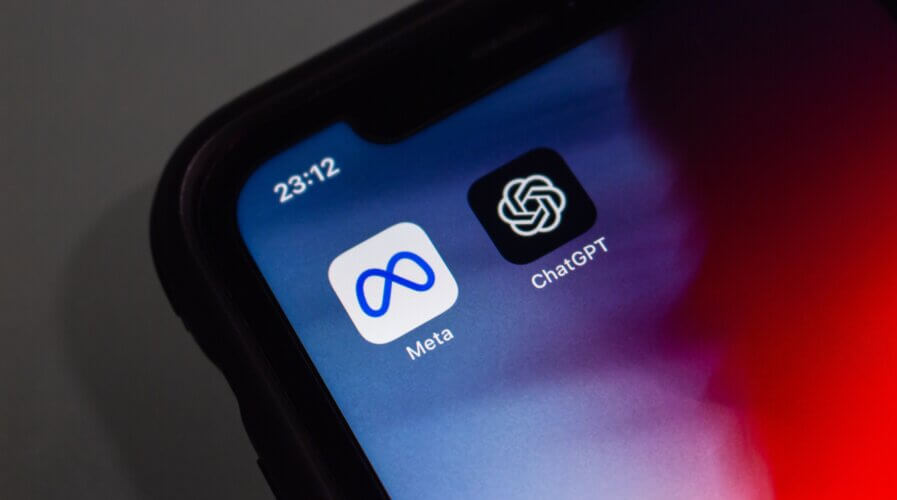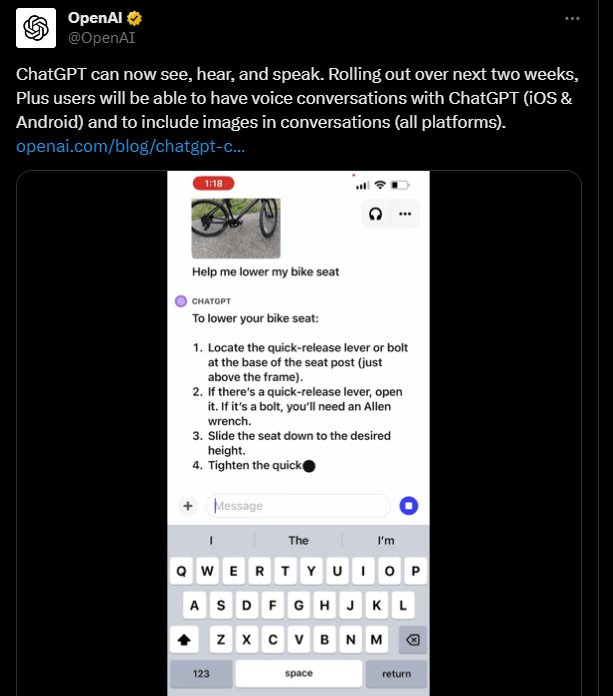
Is Meta truly lagging behind in the AI race? (Source – Shutterstock)
Does Meta’s AI strategy stand a chance against OpenAI’s advances?
- Meta’s AI, powered by Llama 2 LLM, introduces diverse chatbots and tools.
- Despite critiques, Meta is steadfast, embedding AI in cutting-edge products and prioritizing its metaverse initiative.
- It’s likely that Meta and OpenAI will diversify their AI into different applications.
In a landscape dominated by rapid advancements in generative AI, the clash of the titans – Meta and OpenAI – continues to captivate the tech community. While OpenAI’s ChatGPT remains a formidable contender, Meta’s recent endeavors, particularly at the Connect conference, signal an uncompromising ambition to revolutionize the field. But does Meta have what it takes to outpace the competition?
The recent article from AFP published by The Star elucidates a critical standpoint. While skeptics argue Meta lags in the generative AI race, especially when juxtaposed with rivals like ChatGPT, the tech behemoth’s CTO begs to differ.
During Meta’s renowned Connect conference, an event tailored for developers, Andrew “Boz” Bosworth said “The majority of the world’s population will have their first experience of generative artificial intelligence with us.” It’s a bold assertion, given the competitive landscape.
One must recognize the tools Meta introduced at the conference: AI chatbots with intricate personalities, and innovative tools capable of crafting written content or images triggered by voice prompts. Delving deeper into the tech, Meta’s nascent AI bot (still undergoing beta testing) leverages the power of Meta’s Llama 2 large language model (LLM). This model, tailored for niche applications, distinguishes itself from OpenAI’s GPT 4 — the engine propelling ChatGPT.
The complexity of generative AI’s LLMs is undeniable. These models have a voracious appetite for processing power, incurring significant costs. Meta, however, offers an expansive range: a general-purpose Llama LLM boasting 400 billion parameters, and, as highlighted in its white paper, models with a leaner parameter set. Fewer parameters often equate to optimized efficiency, which is crucial to alleviate undue pressures on server CPUs.
Deliberate caution or stagnation?
Meta’s expansive portfolio, encompassing titans like Facebook and Instagram, hasn’t shielded it from criticism. Many in the tech sphere argue that it has trailed behind industry giants such as Microsoft and Google, both of which have been aggressive in championing their generative AI innovations. Yet, undeterred, Meta has strategic plans, like integrating its AI chatbot into avant-garde products: Ray-Ban Meta smart glasses and Quest 3 VR headsets.
Bosworth remains defiant against unfavorable critiques. He fervently believes that Meta has been at the forefront, embedding AI into its platforms even before ChatGPT made its public debut. Bosworth acknowledges the allure of AI tools from competitors, like the much-talked-about Stable Diffusion. Yet, he also emphasizes the often steep learning curves of burgeoning platforms.
Meta’s aspiration is clear: it envisions delivering exceptional, swift results, even on ubiquitous devices like smartphones. As Bosworth illustrates, with Meta’s technology, users can voice straightforward image requests like a whimsical “hedgehog on a bicycle” or a celebratory “birthday greeting to a marathon enthusiast.”
OpenAI’s ChatGPT: the new frontier in AI conversations
While Meta maintains its pace, OpenAI is accelerating relentlessly. Its flagship, ChatGPT, has recently been enhanced with web search capabilities, leveraging Bing for voice and image interactions. This enhancement propels it into direct competition with giants like Microsoft’s AI-powered search engine and even Google’s innovative Bard chatbot. Notably, Microsoft’s AI roots are intertwined with OpenAI’s chatbot technology.
The immersive experience offered by ChatGPT is unmatched. Users can seamlessly converse, fetch facts in real-time during lively debates, or even delegate tasks like narrating bedtime tales. Travel enthusiasts have a bonus: snapping photos of landmarks triggers ChatGPT to provide insightful details about the location.
OpenAI encapsulates the utility of ChatGPT beautifully: “When you’re home, snap pictures of your fridge and pantry to figure out what’s for dinner (and ask follow-up questions for a step-by-step recipe). After dinner, help your child with a math problem by taking a photo, circling the problem set, and having it share hints with both of you.”

OpenAI rolls out voice conversations with ChatGPT (iOS & Android) and to include images in conversations (all platforms). (Source – X)
Meta’s trajectory in AI has been decidedly cautious. Case in point: a mere two weeks before the launch of ChatGPT in 2022, Meta unveiled “Galactica,” an AI chatbot specializing in scientific exploration. It showed prowess in drafting articles and deciphering math quandaries. However, its Achilles’ heel was its sporadic propensity to generate spurious answers.
Its prompt sidelining, Bosworth candidly admits, was in alignment with his perspective. He believed in the bot’s potential, especially given the explicit warnings Meta had provided to users about its unpredictable nature.
Competitors, on the other hand, seemed unfazed by similar hiccups. Their AI offerings remained steadfast in the market, even when occasionally producing idiosyncratic responses, often humorously termed “hallucinations.” Given Meta’s tumultuous affair with content moderation in the past, its present approach leans heavily towards safety and reliability.
As the AI landscape burgeoned and competitors made waves with their offerings, Meta silently yet significantly honed its in-house AI models. This year’s release of the open-source Llama 2 underscores its commitment, allowing developers globally to mold and customize their chatbots.
Meta’s AI vision for the metaverse
Bosworth, a stalwart at Facebook since 2006, recently helmed the division devoted to augmented and virtual reality at Meta. The company’s rebranding in 2021 was a watershed moment, ostensibly aligning with Mark Zuckerberg’s metaverse ethos. Detractors, however, argued it was an attempt to pivot from previous controversies.
As reported by Decrypt, Meta’s commitment, manifesting in billions of dollars invested into realizing its metaverse vision, is commendable. Yet, the road is fraught with challenges. In candid retrospection, Bosworth admits the tepid response to Meta’s Horizon Worlds platform. He humorously remarks on the delayed introduction of virtual limbs for avatars.

Meta stays committed to the metaverse. (Source – Shutterstock)
At the Connect conference, while discussions on the metaverse were notably muted, products like the Ray-Ban smart glasses shone. These “mixed reality” tools present a fascinating amalgamation: they superimpose digital narratives onto our tangible world. This fusion is also poised to grace the upcoming Quest 3 headsets.
Yet, in the relentless pursuit of innovation, compromises are inevitable. Bosworth notes certain design decisions, such as the absence of visible eyes on Quest users, are deliberate, given the trade-offs involved.
Meta’s audacious ambition to carve a virtual and augmented reality niche remains unabated. Zuckerberg envisions AI as a cornerstone in this journey. In recent dialogues with the media, he highlighted the transformative potential of generative AI, especially in crafting multifaceted digital avatars integral to Meta’s product ecosystem.
The AI frontier is dynamic, and as it evolves, tech behemoths like Meta and OpenAI are indomitably shaping the future of human-computer synergy.
READ MORE
- Safer Automation: How Sophic and Firmus Succeeded in Malaysia with MDEC’s Support
- Privilege granted, not gained: Intelligent authorization for enhanced infrastructure productivity
- Low-Code produces the Proof-of-Possibilities
- New Wearables Enable Staff to Work Faster and Safer
- Experts weigh in on Oracle’s departure from adland






